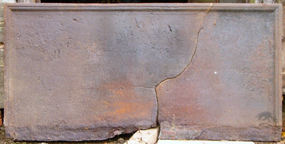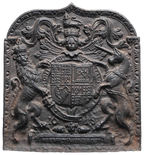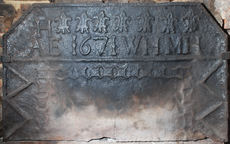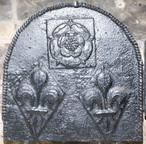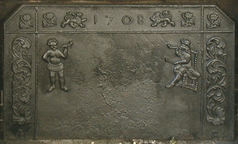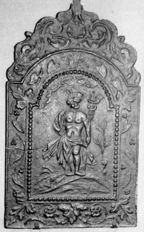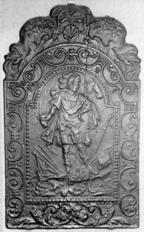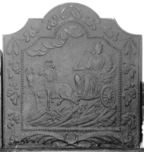-
856
Description: Rectangular; ovolo-moulded edging (top and sides); otherwise plain.
Notes: A base board, possibly used for other firebacks.
- Decoration tags:
- rectangular (shape)
- ovolo (edging)
- whole carved pattern
Manufactured: in the 16th or 17th century possibly in the Weald area of England.
Current location: in private hands, Chailey, East Sussex, England.
- Attached to series:
- Base boards
-
880
Description: Rectangular with ogee arch; ovolo, egg and dart edging; shield, garter, helm, mantling, crest and motto of the English House of Stuart; date split either side of garter buckle.
Notes: One of several firebacks, all of the same date, but varying in size, framing style and moulding; all have stylistic features in common and will have been the work of the same pattern maker, who was also responsible for carving royal coats of arms in three West Country churches. Christie's auction 19 Jun 2012 lot 191 (£1,750).
Copies of this fireback are known.
Inscription: HONI SOIT QVI MAL Y PENSE / 16 18 / DIEV ET MON DROIT
Arms: English Stuart royal (James I)
- Decoration tags:
- ogee-arched rectangular (shape)
- ovolo, egg and dart (edging)
- whole carved pattern
- armorial
- text
Manufactured: in 1618 possibly in the Forest of Dean area of England.
Current location:, not known.
-
1023
Description: Canted rectangle; hatched fillet edging (top and sides); initials in triad to the left; fleur-de-lys stamp repeated seven times across top; date and initial pairs below; full width, horizontal hatched fillet below inscription; zig-zag formed of short, hatched fillets down each side below horizontal fillet; space within bordered by squared cross stamp repeated 12 times horizontally and six times on each side.
Notes: The distinctive squared cross and fleur stamps are seen on other firebacks; the initials in triad may relate to a husband and wife, the pairs of initials to their children; an almost identical fireback seen at Smith's Funeral Services, close to the site of Elmbridge Furnace, at Newent, Gloucestershire, differs only in the alignment of the left-hand column of squared crosses.
Inscription: AHE [triad] 1671 WH MH
- Decoration tags:
- canted rectangular (shape)
- hatched fillet (edging)
- simple stamps
- carved stamps
- individual letters
- individual numbers
- heraldic
- text
- objects
Manufactured: in 1671 possibly at Elmbridge Furnace, Newent in the Forest of Dean area of England.
Current location: in private hands, Coombes, West Sussex, England.
- Attached to series:
- Square cross Dean series
- Date & initials firebacks
- Newent area group
-
1111
Description: Arched shape; twisted rope edging (top and sides); top centre, over-pressed Tudor rose stamp on a square block; large diamond-shaped stamp with fleur-de-lys repeated each side below rose, both over-pressed.
Notes: The diamond-shaped stamp has been seen on other firebacks; one of the stamps appears to have been repositioned twice before casting.
- Decoration tags:
- arched (shape)
- rope (edging)
- simple stamps
- carved stamps
- heraldic
Manufactured: in the mid to late 16th century in the Weald area of England.
Current location: in private hands, Crowborough, East Sussex, England.
- Attached to series:
- Large diamond fleur series
-
55
Description: Canted rectangle; cavetto moulded edging (top and sides); single horizontal fillet below canted corners and vertical fillet parallel to each side, dividing the fireback into two side panels, two top corner panels, top panel and main central panel; ‘daisy’ plant stamp in top corners, and at outer end of top panel enclosing two, opposite facing, lion passant stamps with date between; swirling foliage stamp repeated in each side panel above initial, I to left, B to right; stamp of ‘Indian’ smoking a pipe in top left of central panel, stamp of seated ‘gentleman’ smoking a pipe and holding another, at top right.
Notes: The 'daisy' stamp and the IB initials are identical to those on similar firebacks dated between 1703 and 1721, and probably indicating the same founder. The use of stamps relating to tobacco smoking may suggest an origin near Bristol, the main entry port for the tobacco trade at that time. Lent to Dyrham Park by the late John Workman OBE, of Sheepscombe, Gloucs. in 1963, and given in 1996.
Inscription: 1708 / I B
- Decoration tags:
- canted rectangular (shape)
- cavetto (edging)
- carved stamps
- individual numbers
- heraldic
- text
- animals
- humans
- plants
Manufactured: in 1708 in the Forest of Dean area of England.
Current location: Dyrham Park, Dyrham, Gloucestershire, England.
Museum number: 453259 (part of the National Trust museum group)
- Attached to series:
- IB series
- Date & initials firebacks
-
282
Description: Arched rectangle; cavetto moulded edging; garter enclosing Stuart royal arms, crown, crowned lion and unicorn supporters and motto; initials in top corners.
Notes: The crown is not typically English in form, suggesting that the patternmaker may have been of foreign extraction.
Copies of this fireback are known.
Inscription: C R / [Garter motto - illeg.]
Arms: English Stuart royal
- Decoration tags:
- arched rectangular (shape)
- cavetto (edging)
- whole carved pattern
- armorial
- royal
- text
Manufactured: in the mid to late 17th century in England.
Current location: Chequers, Ellesborough, Buckinghamshire, England.
-
77
Description: 'Dutch' style; arched rectangular shaped central panel, bead edging, two children sitting astride a beast (possibly a winged ram); arched rectangular shaped border, fillet edging, swags of fruit bunches suspended from ribbon; on top, symmetrical floral swirls and flowers.
Notes: The image is probably intended to be Phrixus and Helle riding the winged ram with the golden fleece, but in recasting it has been misinterpreted as the young Samson slaying the lion at Timnath; Judges 14: 5-6.
Copies of this fireback are known.
Inscription: 16 NDW 97 / DER JUNGE SAMSON [the young Samson]
- Decoration tags:
- 'Dutch' (shape)
- fillet (edging)
- whole carved pattern
- individual letters
- individual numbers
- biblical
- monogram
- text
- humans
Manufactured: in the late 17th to early 18th century possibly in the Weald area of England.
Current location: Guildford Museum, Guildford, Surrey, England.
Museum number: G.486 (part of the Guildford Museum museum group)
- Attached to series:
- 'Dutch' NDW series
-
111
Description: 'Dutch' style; arched rectangular shaped central panel with bead edging, semi-naked figure holding a caduceus in his left hand, standing on a mound with a tree to the right and clouds above; arched rectangular shaped border with fillet edging and an ivy and acanthus leaf pattern; on top an arrangement of swirled foliage.
Notes: The figure is Hermes/Mercury, one of a set of 'Eight Deities' engraved by Hendrick Goltzius (1592), after Polidoro da Caravaggio. Formerly part of the Ade Collection (from Grove Hill, Hellingly, Sussex).
Copies of this fireback are known.
- Decoration tags:
- 'Dutch' (shape)
- fillet (edging)
- whole carved pattern
- mythological
- humans
Manufactured: in the mid to late 17th century in England.
Current location: Hastings Museum and Art Gallery, John's Place, Bohemia Road, Hastings, East Sussex, England.
Museum number: HASMG: 1952.51.34 (LA 782) (part of the Hastings Museum museum group)
- Attached to series:
- British 'Dutch' style firebacks
- Eight Deities series
-
130
Description: Arched rectangular shaped central panel with bead on fillet edging; helmeted figure of Mars holding a cutlass in his right hand, standing on a field of flags, spears and cannon; 'Palladian' shaped border with fillet edging enclosing a repeated scrollwork pattern with floral arrangement at base; on top, symmetrical arrangement of scallop shell between two sea serpents and plant fronds.
Notes: Although in the 'Dutch'; style, an absence of this type in continental collections suggests an British source. Formerly part of the Ade Collection (from Grove Hill, Hellingly, Sussex).
Copies of this fireback are known.
- Decoration tags:
- 'Dutch' (shape)
- fillet (edging)
- whole carved pattern
- mythological
- humans
Manufactured: in the late 17th to early 18th century in England.
Current location: Hastings Museum and Art Gallery, John's Place, Bohemia Road, Hastings, East Sussex, England.
Museum number: HASMG: 1952.51.32 (part of the Hastings Museum museum group)
- Attached to series:
- British 'Dutch' style firebacks
-
143
Description: Central panel of arched rectangular shape with cavetto canted corners and bead edging; crowned female figure holding a sceptre in her right hand, seated in a chariot drawn by two caparisoned ponies, a cornucopia at their feet; below, sloping ground with plants, clouds with rain above; identically shaped border with fillet edging and symmetrical swags of flowers and drapery suspended from ribbons; at the base two symmetrical palm fronds tied with a ribbon.
Notes: The figure may represent Ceres, goddess of plenty. The fireback is one of a series designed and made in England, copying the prevailing 'Dutch' style. Its style echoes that of a fireback pattern preserved at Rottingdean Grange, Sussex. Formerly part of the Ade Collection (from Grove Hill, Hellingly, Sussex).
Copies of this fireback are known.
- Decoration tags:
- cavetto-canted arched rectangular (shape)
- fillet (edging)
- whole carved pattern
- mythological
- animals
- humans
Manufactured: in the early 18th century possibly in the Weald area of England.
Current location: Hastings Museum and Art Gallery, John's Place, Bohemia Road, Hastings, East Sussex, England.
Museum number: HASMG: 1952.51.63 (part of the Hastings Museum museum group)
- Attached to series:
- Mayfield 'Dutch' series
- British 'Dutch' style firebacks
